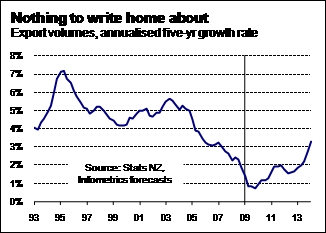Where will our export growth come from?
Over the last five years, New Zealand’s export volumes have grown by an average of just 1.4%pa. During that period, of course, exporters have grappled with a high exchange rate and an international recession. But the growth figure is still the worst in more than thirty years, and continues a trend of a deteriorating export performance since2003. Exports aren’t the be-all and end-all for the economy, but their lacklustre performance highlights the need for New Zealand to alter its economic model if we’re to avoid a debt crisis down the track.

The one feature that has helped keep New Zealand afloat over the last few years has been the terms of trade. Put simply, the price of those products we export has risen, while the price of what we import has fallen – so our purchasing power on the world stage has improved. Without the terms of trade lift, our export incomes in recent years would have looked nowhere near as impressive, and the current account deficit would have been much worse – although arguably financial markets would have driven the exchange rate lower to help offset these negatives.
Unfortunately over the last year, the terms of trade has come under pressure as our export commodity prices have fallen. Looking forward, Infometrics is optimistic that some of that decline in export prices will be reversed, and that the prices of manufactured imports will be held down by soft global demand and international overcapacity. But maintaining a strong terms of trade is only half the equation – growing our export volumes as well would make our external position much stronger. And this is where it’s hard to be optimistic about New Zealand’s prospects.
Our manufacturing sector has come under increasing pressure over the last two decades, due to advance of China and a volatile exchange rate. Between 1989 and 1994, manufactured exports grew by an average of 11%pa. The trend growth rate has slowed consistently since then, averaging just 2.2%pa over the last five years. Prospects for the manufacturing sector don’t look any brighter, with China’s growth set to maintain pressure on New Zealand firms.
Notwithstanding the primary inputs required for the manufacturing sector, achieving an increase in manufacturing production is relatively easy in theory compared to the primary sector. Primary production is much more constrained by stock cycles, the availability of land, weather conditions, and environmental concerns. But if manufacturing is going to continue fading in importance, what hopes do the primary industries hold?
With dairy prices having fallen substantially since mid-2008, the conversion of land to dairy farming has slowed significantly, and so growth in dairy volumes is unlikely to be as strong as we have become used to over the last few years. Indeed, much of the growth in dairy volumes has been achieved at the expense of meat production anyway, as sheep and beef numbers have steadily declined.
Transport costs and the lack of availability of ships have prevented any growth in forestry exports over the last five years. These pressures have eased, but probably only temporarily. As world demand recovers, forestry prices are likely to improve, but exporters will also find themselves struggling against the obstacle of distance that has increasingly inhibited the sector over the last decade.
The Tui and Maari oilfields have generated significant export growth over the last few years, but the typical production profile of an oilfield sees output peak early and then gradually decline over time. Without further oil discoveries, export volumes are likely to shrink, rather than grow, over coming years.
Excluding high-end manufacturing (which has growth potential, but is such a small part of our economy), we are left with services. The largest component, tourism, has struggled to maintain the strong performance achieved throughout the 1990s, with visitors from Australia the only growth market at the moment. That presents its own problem – an increasing proportion of people arriving from Australia are expat New Zealanders visiting family. Typically they don’t spend much money, so provide less export revenue than European, Asian, or American tourists.
Much comment has been passed on how far New Zealand has slipped down the OECD league tables since the 1950s, and how far our incomes have fallen behind those in Australia. But New Zealanders’ lifestyles generally do not reflect our economy’s relative underperformance. Our spending habits are still in 1950s mode, running up debt on the basis that our incomes will catch up at some point. Peering out from the bottom of this recessionary hole, it’s hard to see our export sector filling that brief. On that basis, the stage is being set for a realignment of Kiwis’ expectations about their living standards – and the required adjustment could well be a nasty shock for many people.







